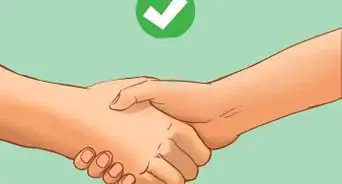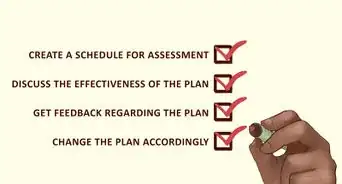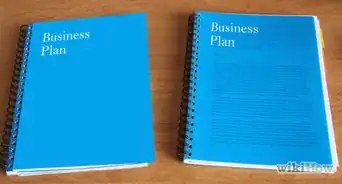This article was co-authored by Michael R. Lewis and by wikiHow staff writer, Amber Crain. Michael R. Lewis is a retired corporate executive, entrepreneur, and investment advisor in Texas. He has over 40 years of experience in business and finance, including as a Vice President for Blue Cross Blue Shield of Texas. He has a BBA in Industrial Management from the University of Texas at Austin.
wikiHow marks an article as reader-approved once it receives enough positive feedback. This article has 19 testimonials from our readers, earning it our reader-approved status.
This article has been viewed 138,356 times.
There are plenty of kids out there running their own successful businesses.To get started, you’ll need a great idea for a business and a solid business plan. Business plans can get pretty complicated, but they don’t have to be. As long as your business plan includes a few crucial things, you’ll have all that you need to get started!
Steps
Developing Your Business Idea
-
1Decide to write a business plan. A business plan outlines how your business will make money and what products or services you will offer. Writing a business plan can help you plan out your business so that you aren't just blindly working. It can also help you determine the costs of setting up and running your business so that they don't come up unexpectedly. A business will also show others (and yourself) that you are really serious about starting a business.[1]
-
2Write down all of your possible business ideas. Think about what special skills you have and also consider businesses that your neighborhood or town might need. You’ll also need to think about how much free time you have to devote to your business.
- Are you currently busy with school or is it summertime? Think about when the work for your business will be done.[2]
- Consider business ideas that are seasonal. For example, if it’s near Christmas, consider ideas that cater to that, like a gift wrapping service or making gift baskets.
- Are you in the middle of a very hot summer? This might be a perfect time to launch a neighborhood lemonade stand.
Advertisement -
3Decide whether you want to offer a product or a service. As you make your list, think about what each of these ideas offers – a product or a service. Are you creating something that you will sell? Or are you performing a specific action that you want to charge money for?[3]
- Examples of product-driven businesses: baking cookies, building birdhouses, making gift baskets, creating greeting cards, selling candy, making doggie treats.
- Examples of service-driven businesses: lawn care, car washing, computer repair, pet sitting, babysitting, cleaning houses, dog walking, and teaching computer skills to older people.[4]
-
4Select the idea that best suits your skills. Are you great with technology and love working with computers? Starting a computer repair service or a device set-up service would be great for you.
- Are you an animal lover? Consider offering pet sitting services.
- Maybe you’re crafty and enjoy making handmade jewelry or gift baskets. These are great products to sell.[5]
-
5Decide on a name for your business. Once you’ve got your idea, you’ll need to come up with a name for your business. A good business name should describe what your business offers and be easy for people to remember.
- Make sure your business name is easy to pronounce, as well.
- Clever and unique business names work well, just remember that the name needs to relate to what your business entails.
-
6Write a short paragraph that describes your business idea and goals. As a future business owner, you’ll need to know your business inside and out. You also need to be able to explain it easily to others, so get your business idea down in words. Describe what you will be offering and why your business is a good idea.[6]
- List any specific objectives and goals for your business, as well.
- Write out what you think makes your product/service unique.[7]
Planning Your Business
-
1Figure out if you’ll need employees.[8] In most cases, you’ll probably be running your business by yourself, at least in the beginning. If you do need additional help to run your business, you will want to keep that expense as low as possible.
- If you have a sibling that wants to help out, that would be a good place to start.
- You will be splitting your profits, so you will need to decide how much and when your employees will be paid.
-
2Make a list of any supplies you will need to get started. Write down how much each supply item on your list costs and total those numbers up. This is your projected start-up cost. If the start-up cost is beyond your current means, talk to your parents or other family members about investing in your business.
- You could also ask your parents if they’d consider donating some of your future allowance as seed money for your business.
- If you bring them a solid business plan, they will be more likely to help you.
-
3List the ongoing expenses you expect to have. For instance, if you are starting a lawn care business, you will need to plan for ongoing expenses like gasoline to fuel your lawn care tools. If you have any employees to pay, that cost also needs to be factored into your ongoing expenses.
- By adding up your ongoing expenses, you will have a pretty good idea of what it will cost to keep your business running.[9]
- Another example – if you’re making cookies to sell, you will need to total up how much the ingredients cost and how often you’ll need to buy them.
-
4Decide what you will be charging for your product/service. Think about how much it costs for you to make your product or perform your service. In order to make a profit, you will need to charge more for your product than it costs you to make it. For instance, if you want to sell cookies by the dozen, you’ll need to figure out how much it costs you to make a dozen cookies.
- Let’s say that when you add up the cost of the ingredients, it costs you $3.50 to make a dozen chocolate chip cookies. You will want to charge more than that for each dozen in order to make a profit.
- You should also factor in how much time it takes you to make your product/perform your service.[10] You can then work out prices based upon how much you want to make. You should also factor in time that you aren't being paid (such as advertising your business or walking to a customer's home).
- For example, if it takes you a half hour to make the chocolate chip cookies mentioned above and another half hour to sell them, you will need to charge an amount that represents the amount of time you spent preparing them. This additional time is your "wage" for preparing them.
- You can work out your hourly wage by dividing your pay for a project or product (minus your expenses) by the amount of time spent working.
- In this case, if you charged $9.50 for the dozen cookies, you would be making $6 for the hour that you spent making and selling them.
- Subtract your expenses from your revenue to get your profit amount.[11]
Marketing Your Business
-
1Figure out who your customers are.[12] Write down all of the different types of customers who you think will want your product/service. For instance, if you’re launching a pet sitting business, some of your customer types would be people that travel for work, people that work long hours, and people that go on vacation.
- You should also consider your market area. Unless you have a car (or your parents' help), market area is relatively small. This may include only areas that you can safely walk or bike to.
- These customer types are called customer profiles. Once you have your customer profiles, you will have a better idea of how to market your business to them.
- Different customer profiles sometimes require entirely different marketing strategies.
-
2Figure out if you have any competitors. Is anyone else in your neighborhood or town offering similar products/services to yours?[13] If so, you will be competing with them for the same customers. What are they charging and how does it compare to what you plan to charge? How will your product/service be better than theirs? Why should people choose your business over theirs?[14]
- You can market most effectively once you know these specific details about your competitors.
- Offering lower prices or providing higher quality products/services are two ways you can compete with them.
- For example, if you start a lawn care business, you will be competing with established lawn care businesses. You can build a customer base by offering better service and encouraging customer recommendations.
-
3Explore your marketing strategy options. Will you be advertising by handing out or posting flyers? If so, where? Will you promote your business on social media? Email marketing? Will you market products door-to-door? Will you have your own website?
- Remember to keep your customer profiles in mind when choosing your marketing strategies.
- For instance, if you’re starting a pet sitting business, you could post flyers at veterinary offices and pet stores, and also hand deliver flyers to people in your neighborhood with pets.
-
4Get or make business cards for your company. These are handy and professional to have, and these days you can order them online for a very low cost. You can even make your own by buying printable business card paper, which always comes with templates to help you get started with designing.
Putting Your Business Plan on Paper
-
1Create a cover sheet with your business name and description. This will be the first page. Write the business name at the top of the paper, then write a business description a few spaces down. All you need for this is a short paragraph that describes your business idea, objectives and goals. If you’ve created a business logo, put it on the cover sheet, as well. Aim for 5-6 sentences.
- Write the business name in large letters, or use a large font, and make it bold. It’s the most important thing on the page.
- The description paragraph can be in a normal size or standard 12 point font.
-
2Begin page 2 with the company’s management and history. Write 1-2 sentences that describe who the business owner is (you) and the management team (your employees, if you have any). Then write 2-3 sentences about your company’s history. Since your company is brand new, your history will cover how you came up with your business idea and why it’s important.[15]
- Owner/Management example: “Kelly’s Doggy Daycare is owned by Kelly Klein. She has several years of experience pet-sitting and truly loves working with and caring for dogs of all kinds.”
- Business History example: "Kelly noticed that most of her neighbors were dog owners who worked long hours every day. Occasionally, they took vacations and/or experienced family emergencies, which could take them away from their pets for days at a time."
- "With her love for dogs, Kelly knew she could provide a pet care service that her neighbors would benefit from, and that’s how Kelly’s Doggy Daycare was born."
-
3Space down and write 3-4 sentences about your product/service. After you write the history and management information, the main part of your business plan will begin. The plan will cover four topics: your product/service, your business objectives, market/competitor information and funding requirements/profit. Try to write 3-4 sentences for each topic.
- You don’t need to get incredibly detailed – summarize and highlight the most important information for each.
- Example for product/service: "Kelly’s Doggy Daycare will provide hands-on pet care for today’s busy pet owner. The business will offer day rates along with in-house extended stay pet sitting. Walking services are included at no charge with every appointment."
-
4Space down and write 3-4 sentences about your business objectives. [16] Discuss the basic goals for your business. Example: "Kelly’s Doggy Daycare will strive to provide the best and most affordable pet sitting services in the area."
- "It’s her mission to put your mind at ease when you have to be away from your pets. Kelly will make sure your pets are loved and cared for in your absence."
- "An email summary of every pet sitting appointment will always be sent to you via email during your absence or upon your return."
-
5Space down and write 3-4 sentences about your marketing information. Talk about what types of customers you envision. Discuss your competition, if any, and your planned marketing strategies.
- Example: “Kelly’s Doggy Daycare caters to today’s busy adults. These are business people who work long hours every day and/or travel regularly for work, family vacationers, and anyone who finds themselves in need of last minute pet care."
- "The business has one competitor, Sam’s Sitting Service, but Kelly offers lower pricing and in-house extended stay care."
- "She plans to post flyers about the new business in her neighborhood to promote it. She will also be going door-to-door to introduce herself and inform neighbors of her services.”
-
6Space down and write 3-4 sentences about your funding needs/profit. List the supplies you will need to start, any expenses you expect, and what you plan to charge for your product/service.[17]
- Example: "Kelly will need very few supplies to launch the business – a bag of doggie treats, 1 dog leash for a small dog and 1 dog leash for a large dog."
- "Ongoing expenses will be the replenishment of doggie treats and occasionally dog toys and/or dog blankets. The rate is $5.00 for each hour of pet care provided. The rate for in-house extended care is $25 per day."
- "Customers will need to provide their own pet food or reimburse Kelly for any food she has to purchase during pet care. Profit for each hour is approximately $3.50 after expenses."
- "Profit for each day of extended care is approximately $18.50 after expenses."
References
- ↑ http://bizkids.com/wp/wp-content/uploads/Kids-Business-Plan.pdf
- ↑ http://www.wisebread.com/create-a-business-plan-by-answering-4-simple-questions
- ↑ http://www.wisebread.com/create-a-business-plan-by-answering-4-simple-questions
- ↑ http://www.mikemichalowicz.com/the-37-greatest-business-ideas-for-young-entrepreneurs/
- ↑ http://www.mikemichalowicz.com/the-37-greatest-business-ideas-for-young-entrepreneurs/
- ↑ http://www.teachingkidsbusiness.com/business-plan-example.htm
- ↑ http://www.teachingkidsbusiness.com/business-plan-example.htm
- ↑ http://www.teachingkidsbusiness.com/business-plan-example.htm
- ↑ http://www.wisebread.com/create-a-business-plan-by-answering-4-simple-questions
- ↑ http://www.wisebread.com/create-a-business-plan-by-answering-4-simple-questions
- ↑ http://content.moneyinstructor.com/664/kids-starting-business.html
- ↑ http://www.wisebread.com/create-a-business-plan-by-answering-4-simple-questions
- ↑ http://www.wisebread.com/create-a-business-plan-by-answering-4-simple-questions
- ↑ http://www.teachingkidsbusiness.com/business-plan-example.htm
- ↑ http://www.teachingkidsbusiness.com/business-plan-example.htm
- ↑ http://www.teachingkidsbusiness.com/business-plan-example.htm
- ↑ http://www.teachingkidsbusiness.com/business-plan-example.htm
About This Article
To make a business plan for kids, create a cover sheet with the business name in large, bold font and a 5-6 sentence description of the business. Have a logo? Include that, too! Start writing up the company’s management and history on the second page, talking about yourself in 1-2 sentences and how and why you came up with your business in another 2-3 sentences. Then craft 3-4 sentences, each, to describe your product or service, business goals, marketing strategy, and funding needs. To learn more from our Entrepreneur co-author, like how much to charge for your product or service, keep reading the article!
-Step-1-Version-4.webp)
-Step-2-Version-4.webp)
-Step-3-Version-4.webp)
-Step-4-Version-4.webp)
-Step-5-Version-3.webp)
-Step-6-Version-3.webp)
-Step-7-Version-3.webp)
-Step-8-Version-3.webp)
-Step-9-Version-3.webp)
-Step-10-Version-3.webp)
-Step-11-Version-3.webp)
-Step-12-Version-3.webp)
-Step-13-Version-3.webp)
-Step-14-Version-3.webp)
-Step-15-Version-3.webp)
-Step-16-Version-3.webp)
-Step-17-Version-3.webp)
-Step-18-Version-3.webp)
-Step-19-Version-3.webp)
-Step-20-Version-3.webp)
-Step-12-Version-2.webp)






















-Step-12-Version-2.webp)






































